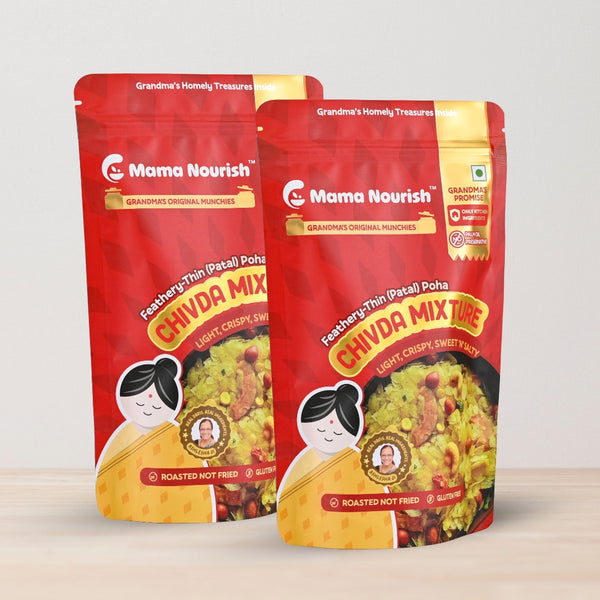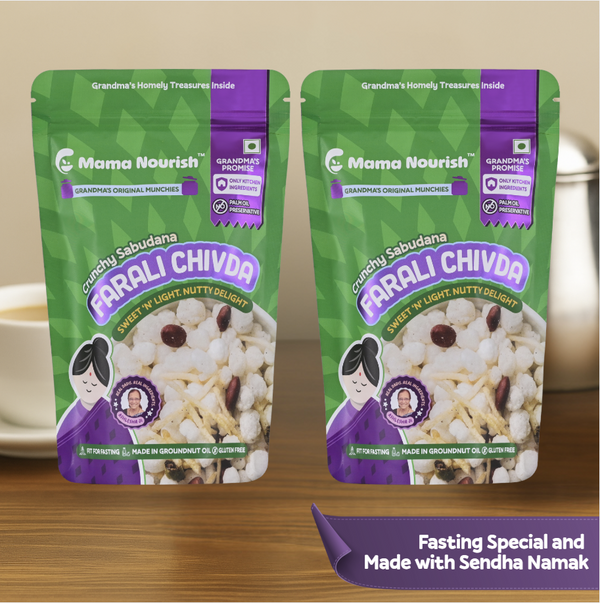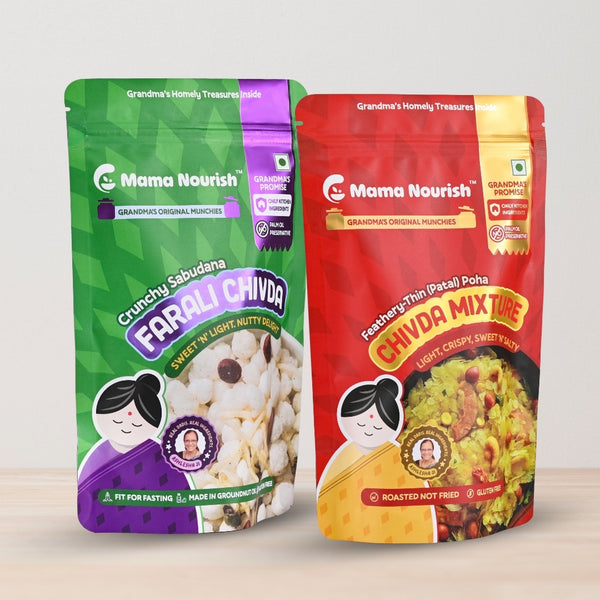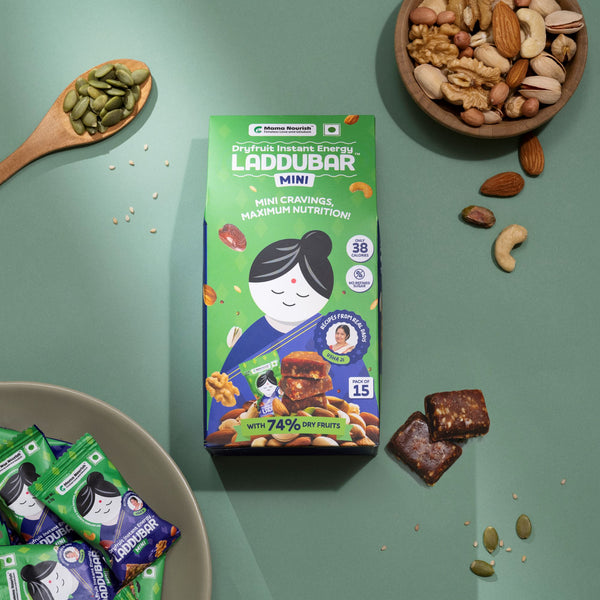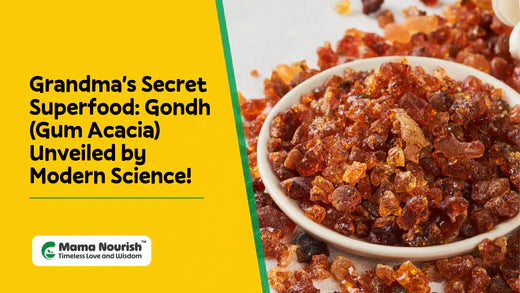
Grandma's Secret Superfood: Gondh (Gum Acacia) Unveiled by Modern Science!
As the winter chill sets in, our bodies naturally crave warmth and nourishment. Whether you're a new mother seeking strength, someone recovering from an illness, or simply a proactive wellness enthusiast, there's a superfood that deserves a place in your pantry—Gondh!
Gondh, or Gum Acacia/ Gum Arabic, is a resin/sap obtained from the Acacia trees, also locally called Babul or Kirkar. This natural treasure is primarily harvested in parts of north and western India and North Africa's Sahel region.
Traditionally, in India, Gondh/gum acacia has been eaten as a key ingredient in delectable Gondh laddus, a nutritious mid-meal snack for the entire family and specifically known and recommended for new mothers.
Gond Laddu has been trusted for hundreds of generations to provide essential nutrients and micronutrients to a new mother, assisting her in postpartum recovery, enhancing milk supply, and strengthening the body while helping her back in shape.
The benefits of gondh extend far beyond just these, making it a revered ingredient in the culinary and medicinal practices of many cultures. Let us read some interesting facts about the origin, uses, nutritional profile, and scientifically proven benefits of this Superfood.
Origin And Journey to Modern-Day Trade

Gond’s journey from Ayurvedic remedy to global commodity is as rich as its nutritional profile. By the 9th century, it was a sought-after product globally.
Fast forward to today, and African nations lead the production of this 'gum gold,' with India, Australia, and South America contributing their native variants.
Types And Benefits
There are two key types of Gond: Acacia gum (Babul/Kikar) and tragacanth gum. Both are famous for their varied health benefits
Gond Acacia: Acacia gum or Arabic gum, sourced from Acacia trees, is the one used in grandmother's Gondh laddus. Provides warmth. The modern food industry also uses it as a binding agent in food preparations. Gum acacia is sourced from Rajasthan and Pakistan.
Gond Katira: Also known as Tragacanth gum, it's derived from the sap of the thorny shrub. When soaked in water, it swells up and becomes a gel-like substance. It's often used in drinks like sherbets or hakimi sharbats, and falooda in Punjab, Rajasthan.
Gum tragacanth, known for its cooling effect, is sourced from Afghanistan and Pakistan.
In India, the acacia trees are geographically distributed in Punjab, Rajasthan and Gujarat. These regions have drier areas, hence suitable for their growth.
The gondh acacia is recommended in Ayurveda as a nourishing ingredient to improve stamina and immunity, treat fatigue, and boost overall health due to its rich nutritional Profile.
Adding Gond to your diet ensures a sufficient daily intake of fibre. It contains Micronutrients like calcium, potassium, magnesium and iron.
While the nutritional profile of Gondh is extensive, let's delve into the top health benefits that make it a modern-day superfood:
Top 6 Scientifically Proven Health Benefits of Acacia Gum/Gondh!
A Rich Fiber Source For Weight Loss

The gum Arabic reduces fat digestion and absorption in the body and hence potentially helps to fight obesity. A 2012 study published in the National Library of Medicine showed that consumption of gum Arabic results in reduction in BMI (Body Mass Index)/and body fat percentage.
The high soluble fibre content in Gum Arabic may promote satiety making it a valuable addition to weight loss diets.
An Ideal Prebiotic Source
Today, many people are aware of the significance of adding prebiotics and probiotics to their diets. Prebiotics are non-digestible food ingredients that encourage the growth of specific beneficial bacteria inside the body and, hence, contribute positively to the overall health of consumers.
The Gum Arabic is identified as an efficient prebiotic dietary fibre by a study, published in the British Journal of Nutrition, Cambridge University Press.
Helps to Reduce Cholesterol Levels

Do you know that as per nutrition research published in ScienceDirect magazine, Fifteen grams of gum acacia administered twice daily to seven hypocholesterolemic male subjects for 30 days reduced their serum cholesterol by approximately 10.4% but had little effect on HDL cholesterol and triglycerides LDL+VLDL (bad cholesterol) cholesterol was decreased significantly.
Increasing cholesterol levels leading to many ailments like heart disease is a major headache for many. In fact, according to WHO, globally, 39% of adults suffer from increased cholesterol levels.
An Anti Diabetic Food Ingredient

Do you know that diabetes causes 1.5 million deaths annually? These worrisome statistics on diabetes led many scholars to study food items with anti-diabetic properties.
Consuming Gum Arabic is known to decrease glucose and insulin among humans.
Aids in Kidney Functions
The Gum Arabic is known to support the smooth functioning of Kidneys.
Aids in Metabolism
According to a scientific studies published in PubMed Gum Arabic may effectively deals with metabolic syndromes.
It improves bowel movements and hence benefits digestion. The increased extraction of calcium is another bonus of consuming Gum Arabic. If you are worried about calcium levels, you can add Calcium-rich laddu made up of Gondh to your diet!
The gum acacia is also studied for its effectiveness in dealing with lower vitamin D levels. As you can see, it's a widely studied food ingredient for its health benefits.
But the most fantastic thing is it's been part of our grandma's recipes since the old days! Are you curious to know about Gond recipes from Grandma’s kitchen? Read on!
So, How Do You Consume Gond? Treasured Recipes from Traditions!

4.1.Gondh Laddu
Known as Gond Panjiri, Gondh Laddu, Pinni Laddo in the north, Dinkache Laadu, Gundar Laddoo in Western India, and Thumma Jiguru in the South, the Gond ladoos has a rich culinary heritage and is considered as a superfood for new mothers.
It is made by adding a handful of dry fruits, nuts, musk melon and poppy seeds, coconut, seeds, gond to roasted whole grain wheat flour, Ginger powder, cumin and white pepper, and ghee.
4.2. Methi Gond Ladoos
Methi Gondh Laddu is a well-known Digestive aid laddu among households in western and Southern India. They are also called Vendhaya Laddu in South India.
It's made up of dry fruits, dates, soaked fenugreek seeds, muskmelon and poppy seeds, Gondh and Kamakas, roasted whole grain wheat flour, Ginger powder, cumin, white pepper, jaggery and cow ghee.
4.3 Gond Ka Sheera/ Halwa
Gond ka sheera is a sweet dish made of milk, cardamom, sugar, ghee, gondh and nuts. It's a popular dish, especially in Gujarat.
4.4. Jaripalla Churma
It's a rich gond dish from Rajasthani cuisine. The main ingredients include wheat flour, began, ghee, semolina, gond, cardamom, nuts, sugar and saffron.
This Rajasthani delicacy is made especially during various festive occasions and as an offering to lord Krisha.
The list of gondrecipies does not end here; you can find more Traditional recipe from grandma's kitchen, like gond burfies, wheat panjeeri, Mukhwas etc.
Embrace the Gondh Goodness!

Incorporating Gondh into your diet isn't just a nod to tradition; it's a choice for a healthier lifestyle. From its rich history to its impressive health benefits, Gondh is truly a superfood that has stood the test of time.
So, why not warm up your winter with a sprinkle of Gondh goodness?
Share

